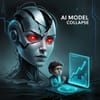As artificial intelligence continues to advance, a new challenge is emerging: the risk of AI model collapse. This phenomenon, where an AI system's performance deteriorates or becomes unreliable, poses significant concerns for developers, users, and the future of AI technology.
AI model collapse occurs when an AI system, which may have initially performed well, begins to produce unexpected or incorrect results. This issue can arise from various factors, including data drift, where the data the model was trained on diverges from the data it encounters in real-world applications, or from fundamental flaws in the model’s design or training process.
One primary cause of model collapse is the shifting nature of the data environment. For instance, if an AI model is trained on historical data that no longer reflects current trends or conditions, its predictions and decisions can become less accurate. This is particularly critical in fields like finance or healthcare, where timely and accurate data is crucial.
Another factor contributing to AI model collapse is overfitting. This happens when a model is excessively tuned to its training data, capturing noise rather than the underlying patterns. While the model may perform exceptionally well on its training data, it can struggle with new or varied data, leading to poor generalization and unreliable performance.
The implications of AI model collapse are far-reaching. In sectors such as autonomous driving, healthcare, and finance, the consequences of a malfunctioning AI system can be severe, potentially affecting safety, financial stability, and health outcomes. As AI systems become more integrated into critical aspects of society, ensuring their reliability and robustness is essential.
Addressing the risk of AI model collapse involves several strategies. Regular updates and retraining of models with current data can help mitigate data drift. Additionally, employing techniques such as cross-validation and robust testing can improve model resilience. It’s also crucial for AI developers to design models with built-in mechanisms for detecting and addressing performance issues.


